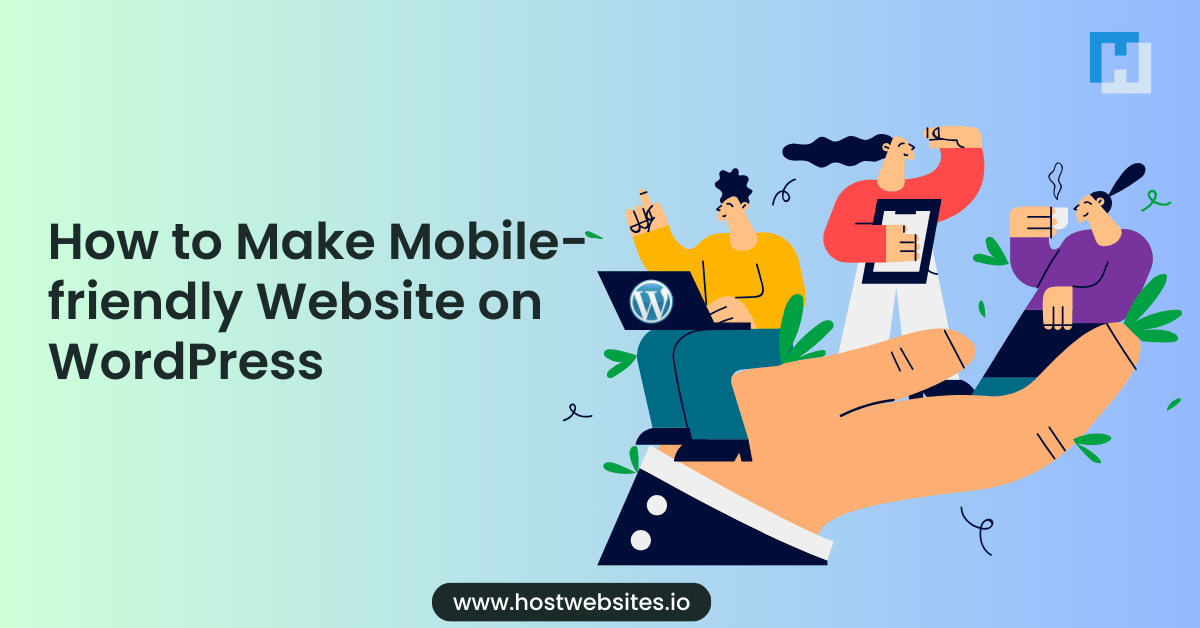In today’s digital age, more users are accessing websites via mobile devices than ever before. According to recent statistics, over 60% of web traffic comes from mobile devices, making it critical to create a mobile-friendly website on WordPress. If your website isn’t optimized for mobile users, you risk losing traffic, customer engagement, and potential sales. Thankfully, if you’re using WordPress, making a mobile-friendly website on WordPress is a straightforward process.
In this article, we will explore the step-by-step process of creating a mobile-friendly website on WordPress. We will cover essential tips, themes, plugins, optimization techniques, and best practices to ensure your website delivers a seamless experience across all devices.
Why Mobile-Friendliness Is Important?
Before we delve into the technical aspects, it’s essential to understand why having a mobile-friendly website on WordPress is crucial:
- SEO Ranking – Google uses mobile-first indexing, meaning it primarily uses the mobile version of your website for ranking and indexing. Without a mobile-friendly design, your rankings in search engine results may suffer.
- User Experience – A well-designed mobile site improves navigation, enhances the user experience and increases engagement. If users have to zoom in or scroll horizontally, they are likely to leave your site.
- Conversion Rates – Mobile optimization can significantly impact your conversion rates. A mobile-friendly e-commerce site, for example, provides a smooth shopping experience that encourages customers to complete their purchases.
- Broader Reach – With billions of smartphone users worldwide, ensuring your site works well on mobile can help you tap into a vast audience and improve overall traffic.
Selecting a Mobile-Responsive WordPress Theme
A key first step in making your mobile-friendly website on WordPress is choosing the right WordPress theme. A responsive theme automatically adjusts the layout and design of your website to fit various screen sizes, including desktops, tablets, and smartphones.
How to Choose a Responsive WordPress Theme
- Mobile Preview – When selecting a theme, check for its mobile preview to ensure the layout and functionality appear well on smaller screens.
- Test the Theme – Most modern WordPress themes are responsive, but it’s essential to test how they work on different devices. Many theme developers provide live demos that allow you to test the responsiveness.
- Optimized for Performance – Beyond responsiveness, ensure the theme is lightweight and optimized for fast loading times, as mobile users tend to leave slow websites.
- Customization Options – Ensure that the theme allows easy customization. You should be able to adjust fonts, colors, and layout elements to fit your brand without affecting responsiveness.
Recommended Mobile-Responsive Themes
Here are some of the best responsive WordPress themes suitable for mobile-friendly website on WordPress:
Astra

A lightweight and highly customizable theme known for its speed and performance. It works seamlessly with page builders like Elementor and Beaver Builder, allowing you to create mobile-friendly website on WordPress designs easily.
OceanWP

A fast, flexible, and responsive theme that offers numerous customization options. It is optimized for SEO and performance, making it perfect for both mobile and desktop users.
GeneratePress

This theme is known for its lightweight structure and focus on speed and performance. It is responsive, SEO-friendly, and offers great flexibility for customization.
Using Plugins to Enhance Mobile Experience
In addition to selecting a responsive theme, there are various plugins available that can help improve the mobile experience of your WordPress site. These plugins can optimize images, improve site speed, and even create mobile-specific designs.
Essential Plugins for Mobile Optimization
- WPtouch – This plugin automatically adds a simple and elegant mobile theme to your WordPress site without modifying the desktop version. It’s an easy-to-use solution for mobile optimization.
- Smush – Smush is an image optimization plugin that reduces the file size of images without compromising quality. Large images can slow down a website, especially on mobile devices, and Smush ensures that your images load quickly and efficiently.
- WP Mobile Menu – This plugin adds a customizable mobile menu to your website. A clear, accessible mobile menu is essential for navigating a website on small screens.
- AMP for WP – Accelerated Mobile Pages – AMP (Accelerated Mobile Pages) is a Google-backed project that speeds up web pages on mobile devices. This plugin helps convert your WordPress pages into AMP-friendly versions, improving loading times on mobile devices.
- Lazy Load by WP Rocket – Lazy loading ensures that images only load when they are in the viewport, reducing initial page load times. This is especially important for mobile users with slower internet connections.
Mobile-Friendly Page Builders
Building a mobile-friendly website on WordPress can be even easier with drag-and-drop page builders. These tools provide mobile-responsive design options, making it simple to create customized layouts that work well on all screen sizes.
Top Page Builders for Mobile-First Design
- Elementor – One of the most popular page builders for WordPress, Elementor provides a visual interface for designing mobile-friendly pages. You can customize every aspect of your design for mobile, including font sizes, padding, and margins, ensuring a perfect fit on all devices.
- Beaver Builder – This drag-and-drop builder also offers mobile-friendly design controls. It allows you to create responsive layouts quickly and efficiently, with previews for mobile, tablet, and desktop views.
- Divi Builder – The Divi Builder, part of the Divi theme, is another excellent choice for creating responsive websites. It provides full control over how your website appears on mobile devices and allows you to preview and adjust your design.
Optimizing Content for Mobile
Responsive themes and plugins are a great start, but your content also needs to be optimized for mobile. Mobile users engage differently with content than desktop users. They tend to scroll quickly and prefer concise, easy-to-read information. Here are some tips to ensure your content is mobile-friendly:
Tips for Mobile Content Optimization
- Use Short Paragraphs – Break up your content into small, digestible paragraphs. This makes it easier for mobile users to read and engage with your content.
- Increase Font Size – Make sure your text is large enough to read comfortably on small screens. A font size of at least 16px is recommended for mobile users.
- Use Headings and Subheadings – Organize your content using headings (H1, H2, H3) to make it easier for mobile users to scan and find the information they need.
- Include Clickable Buttons – Ensure that your call-to-action buttons are large and easy to click on mobile devices. Use clear, prominent buttons to guide users to take action.
- Minimize Pop-Ups – While pop-ups can be useful for capturing leads, they can be intrusive on mobile devices. Use pop-ups sparingly and ensure they are optimized for mobile viewing.
Optimizing Images for Mobile
Large image files can significantly slow down your website, which can be frustrating for mobile users with slower internet speeds. To prevent this, optimize your images for mobile devices.
Tips for Image Optimization
- Use Compressed Images – Compress your images using plugins like Smush or ShortPixel to reduce file sizes without losing quality.
- Use the Correct Image Format – JPEG files are generally smaller in size than PNGs and are suitable for most website images. Use PNGs only when you need transparent backgrounds.
- Enable Lazy Loading – Lazy loading ensures that images are only loaded when they come into view, which speeds up the initial load time of your website.
Speed Optimization for Mobile
Mobile users expect fast load times, and if your site takes too long to load, they may leave before it even finishes. Here’s how to optimize your site speed for mobile devices:
Steps to Optimize Speed for Mobile
- Choose a Reliable Hosting Provider – Your hosting provider plays a significant role in your website’s speed. Opt for a hosting service that offers fast servers and caching options, such as HostWebsites or SiteGround.
- Use Caching Plugins – Caching can drastically improve your site’s speed by storing static versions of your pages. Popular caching plugins for WordPress include W3 Total Cache and WP Rocket.
- Minify CSS, HTML, and JavaScript – Reducing the size of your website’s code can improve loading times. Use plugins like Autoptimize or WP Fastest Cache to minify your CSS, HTML, and JavaScript files.
- Use a Content Delivery Network (CDN) – A CDN stores copies of your website on multiple servers around the world, ensuring that your website loads faster for users regardless of their location. Popular CDN services include Cloudflare and MaxCDN.
- Optimize Your Database – Over time, your WordPress database can become bloated with unnecessary data. Use plugins like WP-Optimize to clean up your database and improve performance.
Mobile-First Design Best Practices
To ensure that your website provides an optimal experience for mobile users, follow these best practices:
Best Practices for Mobile-Friendly Websites
- Design for Mobile First – Start by designing your website with mobile users in mind, then scale up to desktop versions. This approach ensures a smooth experience on all devices.
- Test Your Website on Different Devices – Use tools like Google’s Mobile-Friendly Test and Responsinator to check how your website looks on different screen sizes.
- Use Touch-Friendly Navigation – Ensure that buttons and links are easy to tap on mobile devices. Use larger buttons and make sure links are spaced out to prevent accidental clicks.
- Disable Auto-Play for Videos – Auto-playing videos can be disruptive on mobile devices and may consume users’ data. Ensure that videos are disabled from auto-playing by default.
Testing Your Mobile-Friendly Website
Once you’ve made the necessary adjustments, it’s essential to test your website thoroughly to ensure it is a mobile-friendly website on WordPress.
Tools for Testing Mobile Responsiveness
- Google Mobile-Friendly Test – This tool evaluates your website’s mobile compatibility and provides suggestions for improvement.
- Responsinator – A free tool that lets you see how your website looks on various devices and screen sizes.
- Browser Developer Tools – Most modern web browsers, including Chrome and Firefox, have built-in developer tools that allow you to preview your website on different devices.
Building a mobile-friendly website on WordPress is not only important but necessary in today’s mobile-driven world. By choosing a responsive theme, using plugins to enhance the mobile experience, optimizing images and content, and improving site speed, you can ensure your website is accessible and enjoyable for users on all devices. Following these steps will lead to better SEO rankings, higher engagement, and increased conversions for your business.
With the right approach, you can create a seamless mobile experience on WordPress that caters to the growing number of mobile users visiting your site.
FAQs
Do I need a mobile version of my WordPress website?
If your WordPress site uses a responsive theme, you don’t need a separate mobile version. A responsive theme automatically adapts your site’s layout to fit any screen size, including mobile devices.
What is a responsive WordPress theme?
A responsive WordPress theme adjusts the layout and content of your site to fit various screen sizes. It ensures that your website looks good and functions well on desktops, tablets, and smartphones without requiring a separate mobile version.
Can I make my existing WordPress site mobile-friendly without changing the theme?
Yes, you can use mobile optimization plugins like WPtouch or Jetpack’s mobile module to make your site mobile-friendly without changing the theme. However, switching to a responsive theme is the best long-term solution.
What is lazy loading, and how does it help mobile users?
Lazy loading delays the loading of images and videos until they are about to enter the user’s viewport. This reduces the initial load time of your site, making it faster for mobile users, especially those with slower internet connections.

